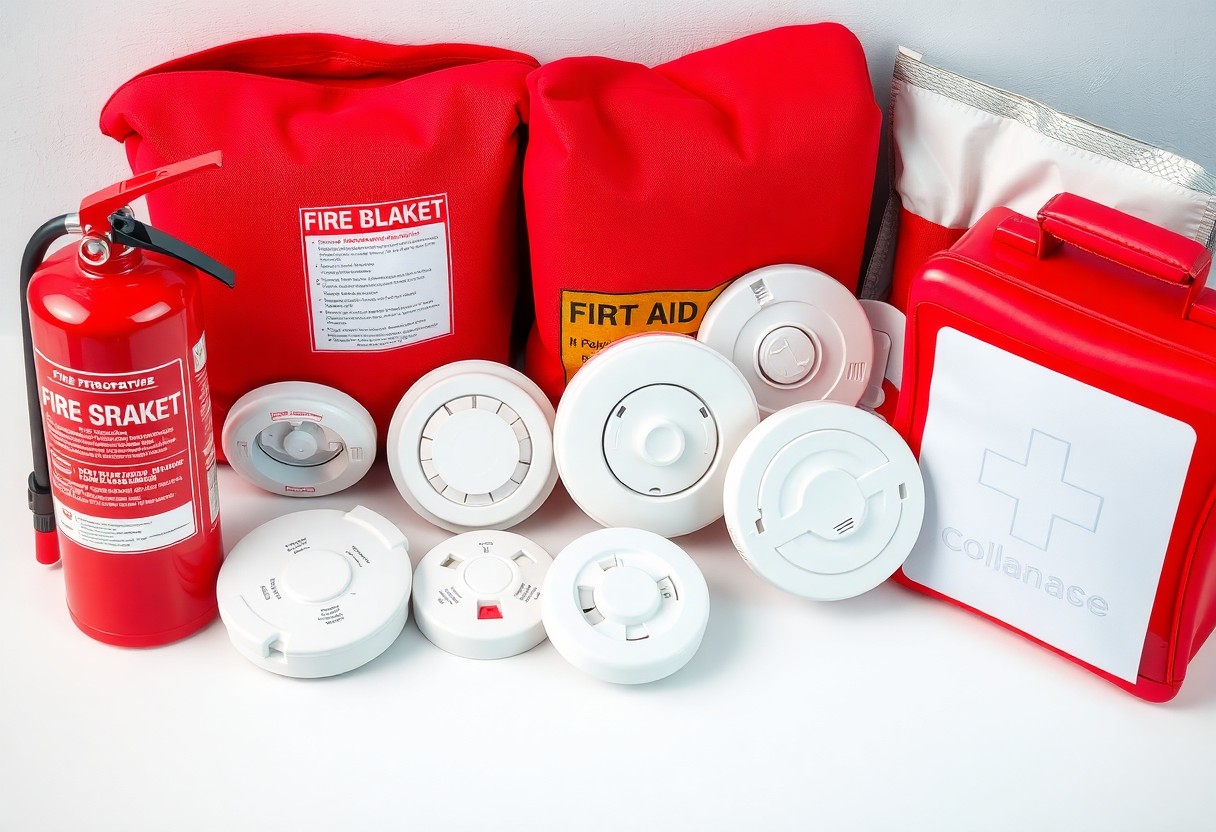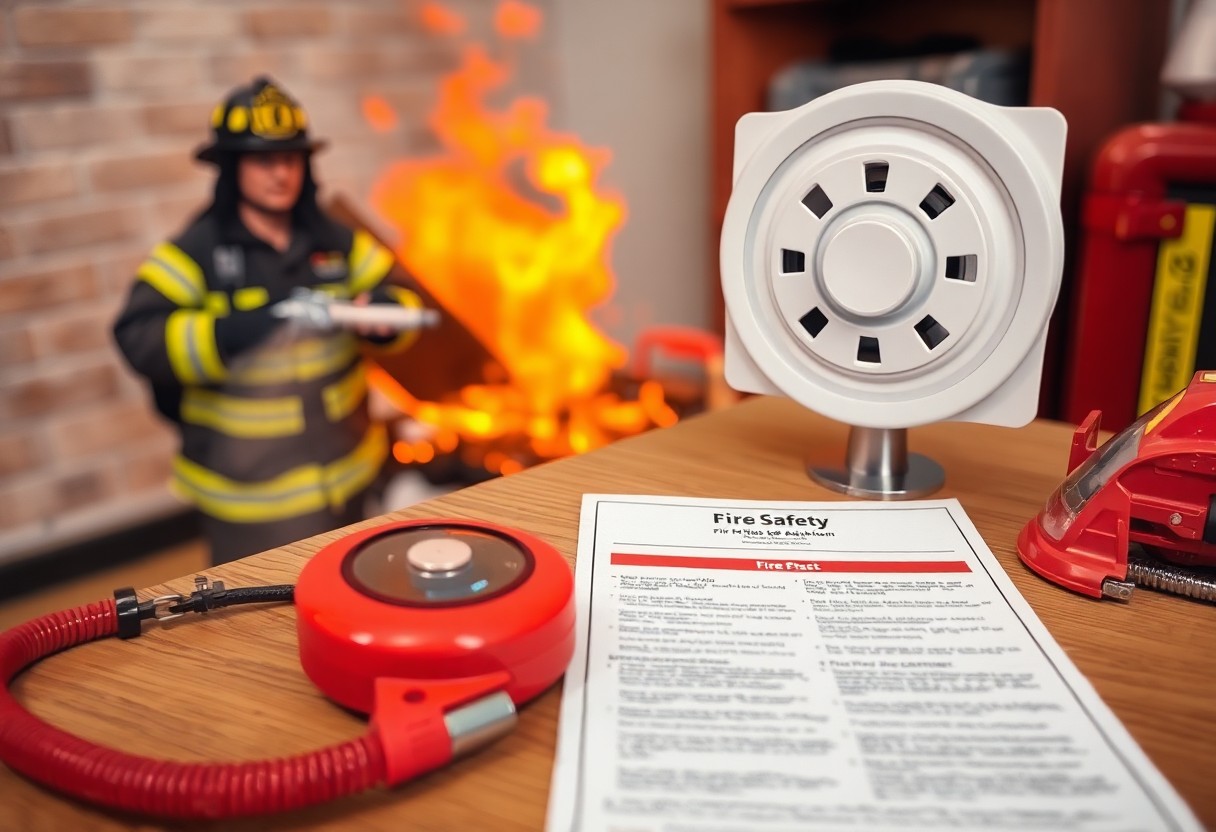Equipment that protects you and your property from the dangers of fire is important for every home and workplace. Understanding which fire safety tools you need and how to properly use them can significantly reduce risks and enhance your safety during an emergency. In this guide, you will learn about the various types of fire safety equipment, including fire extinguishers, smoke alarms, and more, along with important tips for effective usage. Equip yourself with the knowledge necessary to safeguard your environment and ensure the well-being of yourself and others.
Understanding Fire Safety Equipment
Your safety is paramount, and understanding fire safety equipment is vital for protecting yourself and your property. Familiarizing yourself with the types of equipment available and how to use them can make a significant difference in emergency situations. Fire safety equipment can vary in function and purpose, and knowing each type’s role is key to effective fire management.
Types of Fire Safety Equipment
Your safety arsenal should include various types of fire safety equipment. These tools and devices help detect, contain, and extinguish fires, reducing potential damage and ensuring your safety. Key types of fire equipment include:
- Fire extinguishers
- Smoke detectors
- Fire blankets
- Sprinkler systems
- Fire exit signs
Thou should familiarize yourself with each type to ensure you can act effectively when needed.
| Fire Extinguishers | Used to put out small fires |
| Smoke Detectors | Alert you to the presence of smoke |
| Fire Blankets | Suppress flames on a person or object |
| Sprinkler Systems | Automatically extinguish or control fire |
| Fire Exit Signs | Guide people to safety in an emergency |
Importance of Fire Safety Equipment
Little can emphasize how vital fire safety equipment is for the safety of your home and loved ones. Having the right equipment readily available can prevent minor fires from turning into devastating incidents. Being equipped with operational fire safety tools empowers you to act swiftly in an emergency, potentially saving lives and reducing property damage.
Another key aspect is regular maintenance and education regarding these tools. Ensuring that equipment is functional and understanding how to operate it effectively ensures you’re prepared when the unexpected occurs. Familiarize yourself with the equipment and practice using it properly, as this proactive approach contributes significantly to safety and peace of mind.
How to Choose the Right Fire Safety Equipment
There’s a variety of fire safety equipment available, and selecting the right items for your needs is imperative for effective fire protection. Your choices may depend on factors such as your environment, the specific risks involved, and applicable regulations. By understanding these elements, you can make informed decisions that enhance your safety.
Factors to Consider
Clearly, when choosing fire safety equipment, you should consider several factors that influence your selection process:
- Your specific environment – home, office, or industrial setting
- The types of potential fire hazards
- Local fire safety regulations and codes
- The number of occupants in the space
Thou will enhance your effectiveness in fire prevention by evaluating these factors carefully.
Tips for Selecting Equipment
Equipment plays a pivotal role in ensuring your safety and should be chosen with care. Follow these tips to effectively select your fire safety gear:
- Assess your fire risk and choose equipment accordingly
- Check the equipment’s certification and compliance with safety standards
- Ensure accessibility and proper placement of equipment
- Consider regular maintenance and service requirements
Assume that understanding these elements will not only guide you in making better choices but also enhance your preparedness for any fire incident.
Consider the variety of fire safety equipment available to you and explore your options thoroughly. Assessing the specific needs of your environment, such as fire extinguishers, smoke detectors, or fire blankets, will help you determine what is most effective. Ensure that the equipment has the appropriate ratings and certifications, which guarantee its reliability. Additionally, opt for products that come with clear usage instructions and easy maintenance to maximize their reliability. Assume that a well-informed selection will contribute significantly to your overall safety strategy.
- Review manufacturer guidelines for usage and storage
- Seek recommendations from fire safety professionals
- Evaluate user reviews for insights on effectiveness
- Invest in comprehensive training on equipment use
Assume that these considerations will empower you to create a safer environment for yourself and others.
How to Use Fire Extinguishers Effectively
Some fire emergencies can escalate quickly, making it important for you to know how to operate a fire extinguisher effectively. Familiarize yourself with the different types of extinguishers available and their specific uses, as this knowledge can make a significant difference in containing a fire. When you find yourself needing to use one, stay calm and follow the proper procedures to ensure your safety while attempting to suppress the flames.
Understanding the PASS Technique
Understanding the PASS technique is key to using a fire extinguisher properly. PASS stands for Pull, Aim, Squeeze, and Sweep. First, pull the pin at the top of the extinguisher, which breaks the seal. Next, aim the nozzle at the base of the fire rather than the flames. Squeeze the handle to release the extinguishing agent, and finally, sweep the nozzle from side to side until the fire is out. Following these steps helps you effectively target the fire and minimizes risks.
Situational Use of Fire Extinguishers
While fire extinguishers can be used for various types of fires, it’s important to assess the situation before using one. Make sure the fire is small and contained, and that you have a clear exit route. If the fire spreads or you are in doubt about your ability to control it, evacuate immediately rather than risking your safety.
Extinguishers are designed for specific classes of fire, so you need to assess the situation to select the appropriate one. For instance, a Class A extinguisher is ideal for common combustibles like wood and paper, while Class B is meant for flammable liquids such as grease or gasoline. Always check the label before using, and if the flames become unmanageable or you feel unsafe, evacuate and call emergency services immediately.
How to Maintain Fire Safety Equipment
For the effectiveness of your fire safety equipment, it’s vital to establish a regular maintenance routine. Proper upkeep not only extends the lifespan of your equipment but also ensures it will function correctly in an emergency. Familiarize yourself with the manufacturer’s guidelines and standard inspection schedules to help keep your systems in check.
Regular Inspections
Equipment maintenance begins with regular inspections. You should check your fire extinguishers, smoke alarms, and sprinklers frequently to ensure they are in good working order. Make it a habit to conduct monthly visual checks and schedule comprehensive annual inspections to maintain optimal performance.
Signs of Wear and Tear
Some indications of wear and tear include rust, leaks, or a damaged casing on your fire safety equipment. Each of these signs can compromise functionality and safety. Be proactive in addressing these issues to ensure reliable performance when you need it most.
Another important aspect of identifying wear and tear is understanding that components might degrade over time even without visible damage. For instance, hoses and seals can crack, and mechanisms can become less responsive. Regularly testing functionality and looking for any anomalies will help you pinpoint subtle issues before they escalate into major problems. Keep an eye out for expired inspection tags to ensure your equipment remains compliant and safe.
Tips for Fire Safety in Different Environments
After considering the unique characteristics of various environments, you can enhance your fire safety measures by following these specific tips:
- Assess your surroundings and identify potential fire hazards.
- Ensure that fire exits are clearly marked and unobstructed.
- Regularly check and maintain fire extinguishers and alarms.
- Establish a clear evacuation plan specific to the environment.
Any environment can benefit from tailored fire safety strategies to reduce risks effectively.
Home Fire Safety Tips
Any home can be made safer by implementing these vital fire safety measures:
- Install smoke detectors on every level of your home.
- Keep a fire extinguisher in the kitchen and garage.
- Create a family escape plan and practice it regularly.
- Never leave cooking unattended and keep flammable materials away from heat sources.
Perceiving the potential risks and taking preventive actions will help protect your loved ones and property.
Workplace Fire Safety Guidelines
Safety in the workplace begins with being aware of fire hazards and knowing how to respond effectively.
Tips for maintaining workplace fire safety include ensuring that everyone has undergone fire safety training, conducting regular fire drills, and clearly marking emergency exits. Maintain clear access to fire-fighting equipment, and regularly inspect fire alarms and suppression systems. Establishing and upholding these guidelines fosters a proactive approach towards fire safety in your workplace, leading to a safer environment for all employees.
Preparing for Fire Emergencies
To ensure your safety during a fire emergency, it’s important to prepare ahead of time. This involves assessing your environment, identifying potential fire hazards, and knowing the location of fire safety equipment. By educating yourself and your family about emergency procedures, you can significantly enhance your preparedness, making it easier to respond effectively if a fire does occur.
Creating a Fire Escape Plan
Fire safety starts with a comprehensive escape plan. Identify multiple exit routes from each room in your home, and practice these routes regularly. Designate a safe meeting place outside where everyone can gather, ensuring that all members of your household know where to go in case of a fire.
Training and Drills
Fire drills are an important part of your fire safety strategy. These exercises prepare you and your family for a real emergency, enabling everyone to practice their escape plans and familiarize themselves with the sound of smoke detectors. Conducting drills regularly will help instill confidence and ensure each person knows their role during a fire, minimizing panic and confusion.
Understanding the importance of training and drills can make a significant difference in an emergency. You should schedule these practice sessions at least twice a year, involving all members of your household. This repetition helps everyone internalize the steps they need to take, ensuring a quicker and more efficient response when every second counts. Additionally, consider including discussions about fire safety fundamentals, such as identifying smoke detectors and using fire extinguishers, to enhance your overall preparedness.
Conclusion
With these considerations, you are better equipped to make informed decisions about fire safety equipment. Understanding the necessary tools—such as fire extinguishers, smoke detectors, and fire blankets—and knowing how to use them correctly can significantly enhance your safety and that of your loved ones. Regular maintenance and practice are key to ensuring that these devices function effectively when needed. By prioritizing fire safety in your home or workplace, you can create a secure environment and reduce the risks associated with fire hazards.


